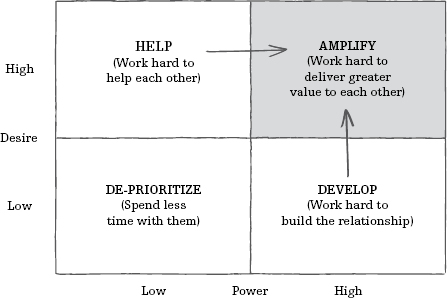32
When you want to build powerful relationships quickly
To enjoy your job, you want powerful relationships with great people. This drives everything – the quality of your conversations, the ease with which you get things done, your sense of fulfillment at work and home, and how successful you are. As Tony Robbins says: “People’s lives are a direct reflection of the expectations of their peer group.”
Given how important relationships are, you’ll want to get them right. Fortunately, there are only three main things to focus on:
1. Know the right people
Networking takes time. It’s bound to, I suppose. After all, it’s called net-work, not net-wait-for-something-to-happen.
So, to get best results when networking, spend the most time with people who have both the:
- Power to help you; and
- Desire to do so.
A simple way to evaluate your current network is to grade each of your main contacts’ Power and Desire, and plot them on the following chart:

So, in my chart, 1 might be a CEO who thinks you’re great (high power and desire); 2 might be a Board member who doesn’t know you well (high power but low desire); and 3 could be the new part-time junior who doesn’t know you at all (low both).
This chart helps show:
- The strength of your network – do most of your contacts have the power and/or desire to help?
- What to do with each person on there.

Three quick notes to help you:
2. See your contacts the right number of times
It’s pretty obvious that you should see people the “right number of times”. In fact, it’s so obvious that – if work and life didn’t get in the way – you wouldn’t need this section.
But, unfortunately, work and life do get in the way. And when you’re busy and your brain’s full of all sorts of stuff, it’s easy to forget to spend time with the people you should be seeing (or spend too long with those you shouldn’t).
So, make it easier by inserting recurring diary reminders to speak to them. This means you never have to remember it yourself.
If it helps, use a KITE table (where KITE stands for Keep In Touch Every):

Then, group all the same types – e.g. the “monthlies” – in one recurring diary entry called “contact the following people: X, Y, Z”. When the reminder comes up every month, just do what the diary says!
Some people feel KITE is over the top. And for you it might be. But, in my experience, these same people often also tell me “I really must speak to Mrs. X more often”.
3. Have the right conversations
I think my previous bank manager used to have a KITE table. Every month – without fail – he’d call to try and sell me something.
Hmmm . . . that’s not relationship building; that’s selling (these two are like oil and water – your business needs both, but they don’t mix very well). In fact, it wasn’t really “selling”; it was just annoying.
So, when you contact people, remember the Golden Rule of relationship building:
Or, if you prefer, make sure they think “I’m glad he called”. There are lots of things you can do to achieve this:
There are loads. You’ll notice quite a few include the word “ask” – the next chapter has more on how to do this well. You’ll also notice none involve shoving banking products down someone’s throat!
One final point: these don’t take much time/effort, but all bring huge value to your contacts, and therefore to you. Even better, you can leverage the ones you choose. For instance, one month, you might share the same article with lots of different people. Each of them thinks “I’m glad he called”, and it wasn’t at all onerous for you.
In many ways, this is one of the most important chapters in the book. Build great relationships with great people, and success becomes inevitable. What one action could you take, to be even better at it?

